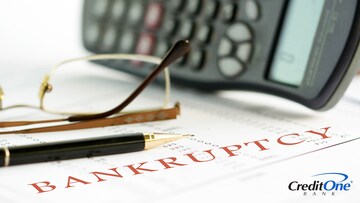
Understanding Chapter 7 Bankruptcy
July 02, 2025
Chapter 7 bankruptcy offers a way to halt ongoing debt. Here’s how to dispel common myths and take steps toward a more stable, confident future.

Introduction
Chapter 7 bankruptcy offers a path for individuals who feel overwhelmed by debt and don’t see a realistic way out through regular payments. If you’ve ever been in this position, you’re not alone. In fact, bankruptcy filings have been steadily rising.
According to the Administrative Office of the U.S. Courts, 517,308 bankruptcy cases were filed in 2024, which is a noticeable increase from 452,990 filings in 2023. This upward trend shows that many people are turning to bankruptcy for relief when other financial solutions aren’t enough.
In this article, you’ll learn how Chapter 7 bankruptcy works, what happens after you file, and how to rebuild your financial life once the process is complete.
Key Differences Between Chapter 7 and Chapter 13 Bankruptcy
Each chapter addresses different financial circumstances, and it’s important to understand why each one is unique and when it makes the most sense to use it.
Chapter 7 bankruptcy
If you have limited income and minimal assets, Chapter 7 might be the better option. It’s geared toward erasing your legal responsibility to repay personal debts, like credit card or medical debt, by selling off your non-essential assets. For many people, especially those with few possessions or whose earnings fall below a set threshold, Chapter 7 provides a faster route to relief.
Chapter 13 bankruptcy
On the other hand, Chapter 13 is designed for those who earn enough to repay at least a portion of their debts over time. It restructures your debt into a manageable payment plan that usually lasts three to five years. It works well for people who have taken on too much debt and need time to get caught up on overdue payments.
What Happens After Filing Chapter 7 Bankruptcy
Once your Chapter 7 case is filed and processed, the court releases, or discharges, most of your qualifying debts. This gives you a fresh start, but that relief comes with some adjustments afterward.
Your bankruptcy will appear on your credit report for up to 10 years, which may seem overwhelming. But over time, the impact can lessen, especially if you work to rebuild your financial life.
Most discharged debts disappear quickly from your monthly obligations, giving you some space to refocus your budget and priorities. Secured debts — like car loans or mortgages — can remain if you want to keep those assets and continue payments.
Within a few months of your case closing, you’ll likely notice changes in how lenders view you. While bankruptcy doesn’t erase all your financial challenges, it marks a turning point. With each step you take afterward, you move toward stability and control.
Rebuilding Your Credit After Chapter 7 Bankruptcy
Rebuilding your credit score takes active effort and daily decisions that move you forward. Start with tools that are designed for people in your situation.
One strong step is applying for a rebuilding credit card or secured card. When used appropriately, secured cards can create a good credit history. Keep the balance low, make timely payments, and treat it like a stepping stone, not a fallback.
If you’re unsure which card to get, try using a credit card finder to explore options tailored to your credit profile. Selecting a card that matches your objectives can make a world of difference when it comes to staying accountable.
Managing Your Money and Savings After a Bankruptcy
Reorganizing your finances after bankruptcy is about more than fixing your credit score. You also have to build new habits, so you don’t fall back into old patterns. That starts with creating a budget you can realistically stick to.
Track every dollar
Assign each expense to a category and build in breathing room for irregular costs. Tools and apps can help, but your consistency matters more than the platform you use. Eventually, budgeting goes from being a limitation to being a clear and straightforward path toward your goals.
Save for rainy days
Begin by opening a basic savings account to serve as your emergency fund. Even $10 or $20 a week adds up and gives you peace of mind when unexpected expenses pop up. If you want to set aside money with a longer time frame, consider saving up for a certificate of deposit (CD) or exploring other deposit options that pay a high yield.
When it comes to financial recovery, consistency beats perfection. You don’t have to completely change your life in one day. You can simply take small steps that are right for you.
Common Myths About Chapter 7 Bankruptcy
Filing for bankruptcy can be an emotional and confusing decision, and false assumptions can keep you from understanding the protections and benefits that Chapter 7 can offer.
Let’s dispel some of the myths so you feel informed when you make your next steps:
You’ll lose everything
You may have heard that filing Chapter 7 means losing everything, but that isn’t the case for most people. Bankruptcy laws include exemptions that protect essential property like your home, car, and basic household items, depending on the laws in your state. Creditors aren’t looking to take everything. There are legal limits that allow you to hold on to what you need to rebuild.
Your credit will be ruined forever
Another widespread belief is that bankruptcy permanently destroys your credit. While Chapter 7 does lower your credit score, it doesn’t mean you’ll never recover. Some people may actually see gradual improvement within a few years if they begin rebuilding responsibly. Just keep in mind: a Chapter 7 filing can stay on your credit report for up to ten years, even if your debts are discharged sooner.
Bankruptcy means you’ve failed
Some people believe that choosing bankruptcy means giving up or failing. However, using Chapter 7 is a legal way to regain stability when your financial situation becomes unmanageable. It’s a reset, not a reflection of your character. Life happens, and this process exists to help you recover.
Bottom Line
Chapter 7 is a financial tool designed to help you restart. When you replace fear with facts and put steady effort behind your decisions, you can begin building a stronger, more stable financial future.



